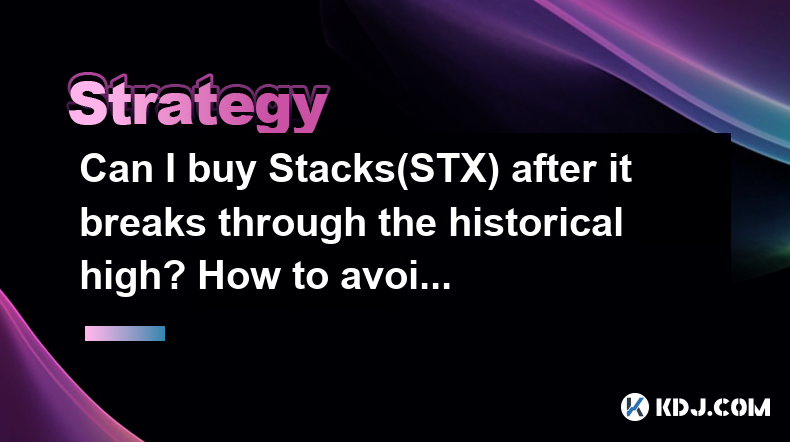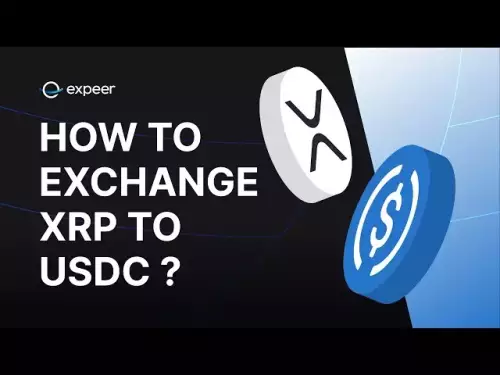-
 bitcoin
bitcoin $112715.707551 USD
-1.71% -
 ethereum
ethereum $4101.475385 USD
-3.01% -
 tether
tether $1.000644 USD
-0.02% -
 bnb
bnb $1207.619465 USD
-6.77% -
 xrp
xrp $2.501451 USD
-3.98% -
 solana
solana $202.947124 USD
-3.32% -
 usd-coin
usd-coin $1.000295 USD
0.04% -
 dogecoin
dogecoin $0.203884 USD
-4.47% -
 tron
tron $0.317154 USD
-1.72% -
 cardano
cardano $0.695009 USD
-4.43% -
 hyperliquid
hyperliquid $38.853961 USD
-8.23% -
 chainlink
chainlink $18.988674 USD
-4.64% -
 ethena-usde
ethena-usde $1.000233 USD
-0.03% -
 stellar
stellar $0.337050 USD
-3.63% -
 bitcoin-cash
bitcoin-cash $536.861728 USD
-1.28%
Can I buy Stacks(STX) after it breaks through the historical high? How to avoid taking over?
After STX breaks through its historical high, use limit orders and dollar-cost averaging to buy, and monitor market sentiment to avoid overpaying.
Apr 30, 2025 at 02:28 pm

Introduction to Stacks (STX)
Stacks (STX) is a cryptocurrency that aims to enable smart contracts and decentralized applications on the Bitcoin blockchain. It uses a unique consensus mechanism called Proof of Transfer (PoX), which allows miners to mine STX while still contributing to the security of the Bitcoin network. Given its innovative approach, many investors are keen to understand how to navigate buying STX, especially after it breaks through historical highs.
Understanding Historical Highs and Breakthroughs
When a cryptocurrency like STX breaks through its historical high, it often signals strong market interest and potential for further growth. A historical high is the highest price point that a cryptocurrency has ever reached. A breakthrough occurs when the current price exceeds this previous peak. This event can attract more investors and traders, but it also comes with increased volatility and risk.
Strategies for Buying STX After a Breakthrough
Buying STX after it breaks through its historical high requires careful planning and consideration of various factors. Here are some strategies to consider:
Timing the Market
Timing the market is challenging but crucial when buying after a breakthrough. Look for signs of consolidation after the initial surge. This could indicate that the price might stabilize before another potential upward movement. Utilize technical analysis tools like moving averages, RSI, and MACD to identify potential entry points.
Dollar-Cost Averaging
Dollar-cost averaging (DCA) can be an effective strategy to mitigate risk. Instead of investing a lump sum at the peak, spread your investment over time. This approach allows you to buy more STX when the price is low and less when it's high, potentially reducing the average cost per token.
Setting Stop-Loss Orders
To protect your investment, consider setting stop-loss orders. These are predetermined levels at which your STX will be sold automatically if the price drops to a certain point. This can help limit potential losses if the market turns against your position.
How to Avoid Taking Over When Buying STX
Avoiding taking over, or overpaying, for STX after a breakthrough involves careful analysis and disciplined trading. Here are some steps to help you avoid this pitfall:
Conduct Thorough Research
Before buying, conduct thorough research on STX's fundamentals and market conditions. Understand the project's roadmap, team, and any recent developments that might affect its price. This knowledge will help you make informed decisions and avoid buying at an overvalued price.
Use Limit Orders
Instead of using market orders, which can result in buying at the current market price (which might be inflated during a breakthrough), use limit orders. With a limit order, you set the maximum price you're willing to pay for STX. If the market price reaches your limit, the order will be executed; otherwise, it will not be filled.
Monitor Market Sentiment
Market sentiment can greatly influence cryptocurrency prices. Use social media, forums, and news outlets to gauge the sentiment around STX. Be cautious of hype-driven price spikes, as they can lead to overpaying. Look for a balanced view of the project's potential and risks.
Diversify Your Portfolio
Diversification is key to managing risk. Instead of putting all your funds into STX, consider spreading your investment across different cryptocurrencies and asset classes. This approach can help mitigate the impact of a potential price drop in STX.
Practical Steps to Buy STX
Here's a detailed guide on how to buy STX, focusing on avoiding overpaying:
Choose a Reliable Exchange: Select a reputable cryptocurrency exchange that supports STX. Examples include Coinbase, Binance, and OKEx. Ensure the exchange has a good track record and security measures in place.
Create and Verify Your Account: Sign up for an account on the chosen exchange. You'll need to provide personal information and complete a KYC (Know Your Customer) verification process, which may involve submitting identification documents.
Deposit Funds: Once your account is verified, deposit funds into your exchange wallet. You can typically use bank transfers, credit/debit cards, or other cryptocurrencies like Bitcoin or Ethereum.
Place Your Order: Navigate to the STX trading pair on the exchange. Decide whether to use a market order or a limit order. For avoiding overpayment, a limit order is recommended. Enter the amount of STX you want to buy and set your maximum price.
Monitor and Adjust: After placing your order, monitor the market closely. If the price moves in your favor, consider adjusting your limit order to secure a better price. If the market moves against you, reassess your strategy and be prepared to cancel or modify your order.
Secure Your STX: Once your order is filled, transfer your STX to a secure wallet. Hardware wallets like Ledger or software wallets like MetaMask provide better security than leaving your tokens on an exchange.
Analyzing STX's Market Performance
To make informed decisions about buying STX after a breakthrough, it's important to analyze its market performance. Consider the following factors:
Price Volatility
STX, like many cryptocurrencies, can experience significant price volatility. After a breakthrough, the price may continue to rise or experience a correction. Use volatility indicators like the Bollinger Bands to assess the potential for price swings.
Trading Volume
High trading volume after a breakthrough can indicate strong market interest. Monitor the volume to gauge whether the price movement is supported by genuine buying pressure or if it's driven by speculation.
Market Trends
Look at broader market trends to understand STX's performance in context. If the entire cryptocurrency market is experiencing a bull run, STX's breakthrough might be part of a larger trend. Conversely, if the market is bearish, the breakthrough might be short-lived.
Frequently Asked Questions
Q: What are the risks of buying STX after a breakthrough?A: The primary risks include buying at a peak price, which could lead to significant losses if the price corrects. Additionally, the market may be overhyped, leading to a bubble that eventually bursts. Always assess the risk-reward ratio before investing.
Q: How can I stay updated on STX's price movements?A: Use cryptocurrency tracking apps like CoinGecko or CoinMarketCap, set up price alerts, and follow STX-related news and social media channels. Joining STX-focused communities can also provide real-time insights.
Q: Can I use leverage to buy STX after a breakthrough?A: While leverage can amplify gains, it also increases risk. If you choose to use leverage, ensure you understand the terms and have a solid risk management strategy in place. Be cautious, as leveraged positions can lead to significant losses if the market moves against you.
Q: Are there any regulatory considerations when buying STX?A: Yes, regulatory environments vary by country. Ensure you comply with local laws and regulations regarding cryptocurrency trading. Some jurisdictions may have specific rules about buying and holding STX, so it's important to stay informed.
Disclaimer:info@kdj.com
The information provided is not trading advice. kdj.com does not assume any responsibility for any investments made based on the information provided in this article. Cryptocurrencies are highly volatile and it is highly recommended that you invest with caution after thorough research!
If you believe that the content used on this website infringes your copyright, please contact us immediately (info@kdj.com) and we will delete it promptly.
- Zero Knowledge Proof, Whitelist, Blockchain 2025: The Dawn of Private, Scalable Infrastructure
- 2025-10-16 01:20:01
- Altcoins, Whales, and Tariff Threats: Navigating the Crypto Seas
- 2025-10-16 01:20:01
- ChatGPT's Crystal Ball: HBAR Price Prediction and the Rise of Snorter in 2025
- 2025-10-16 01:20:01
- ZEROBASE Listing and Airdrop: A New Era for ZK Tech?
- 2025-10-16 00:25:13
- Digital Euro, Gold Standard, and Active Reserves: A New York Minute on the Future of Money
- 2025-10-16 00:25:13
- TCG OTS Pack Spoilers: What's Hot and What's Not?
- 2025-10-16 00:33:47
Related knowledge

Practical parameter settings for a Bitcoin multi-timeframe moving average system
Sep 18,2025 at 10:54pm
Optimizing Timeframe Combinations for Bitcoin Trading1. Selecting appropriate timeframes is crucial when building a multi-timeframe moving average sys...

How can I filter out false breakouts in Dogecoin high-frequency trading?
Sep 22,2025 at 01:00am
Understanding False Breakouts in Dogecoin Trading1. A false breakout occurs when Dogecoin's price appears to move beyond a defined support or resistan...

Techniques for identifying tops and bottoms in the Bitcoin on-chain NVT model
Sep 20,2025 at 07:54pm
Understanding the NVT Model in Bitcoin Analysis1. The Network Value to Transactions (NVT) ratio is often described as the 'P/E ratio' of the cryptocur...

What does the surge in open interest in Bitcoincoin futures mean?
Sep 20,2025 at 11:18pm
Understanding the Surge in Dogecoin Futures Open Interest1. A surge in open interest within Dogecoin futures indicates a growing number of active cont...

How can I use the Ethereum USDT premium to gauge market sentiment?
Sep 18,2025 at 11:55pm
Understanding the Ethereum USDT Premium1. The Ethereum USDT premium refers to the price difference between USDT (Tether) traded on Ethereum-based plat...

What should I do if Ethereum staking yields decline?
Sep 20,2025 at 06:18am
Understanding the Causes Behind Declining Ethereum Staking Yields1. The Ethereum network transitioned to a proof-of-stake consensus mechanism with the...

Practical parameter settings for a Bitcoin multi-timeframe moving average system
Sep 18,2025 at 10:54pm
Optimizing Timeframe Combinations for Bitcoin Trading1. Selecting appropriate timeframes is crucial when building a multi-timeframe moving average sys...

How can I filter out false breakouts in Dogecoin high-frequency trading?
Sep 22,2025 at 01:00am
Understanding False Breakouts in Dogecoin Trading1. A false breakout occurs when Dogecoin's price appears to move beyond a defined support or resistan...

Techniques for identifying tops and bottoms in the Bitcoin on-chain NVT model
Sep 20,2025 at 07:54pm
Understanding the NVT Model in Bitcoin Analysis1. The Network Value to Transactions (NVT) ratio is often described as the 'P/E ratio' of the cryptocur...

What does the surge in open interest in Bitcoincoin futures mean?
Sep 20,2025 at 11:18pm
Understanding the Surge in Dogecoin Futures Open Interest1. A surge in open interest within Dogecoin futures indicates a growing number of active cont...

How can I use the Ethereum USDT premium to gauge market sentiment?
Sep 18,2025 at 11:55pm
Understanding the Ethereum USDT Premium1. The Ethereum USDT premium refers to the price difference between USDT (Tether) traded on Ethereum-based plat...

What should I do if Ethereum staking yields decline?
Sep 20,2025 at 06:18am
Understanding the Causes Behind Declining Ethereum Staking Yields1. The Ethereum network transitioned to a proof-of-stake consensus mechanism with the...
See all articles










































































